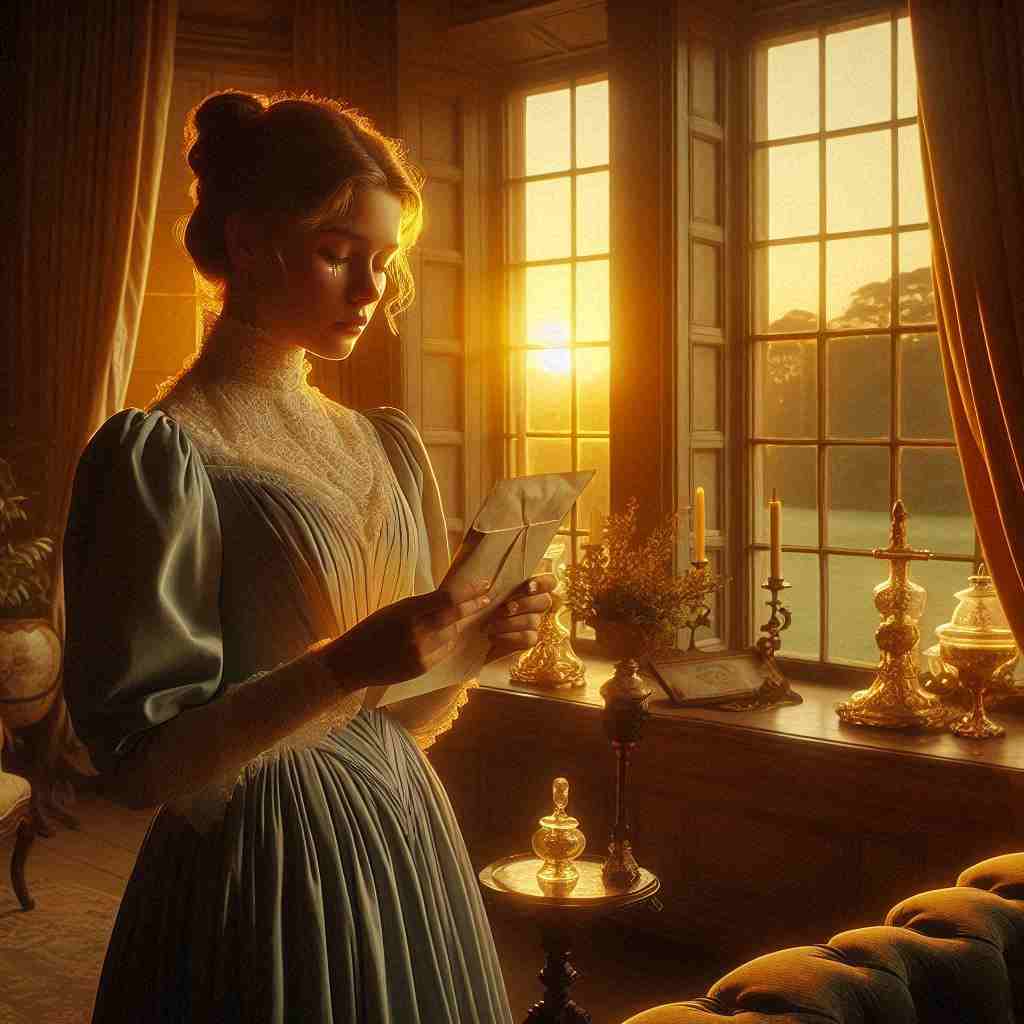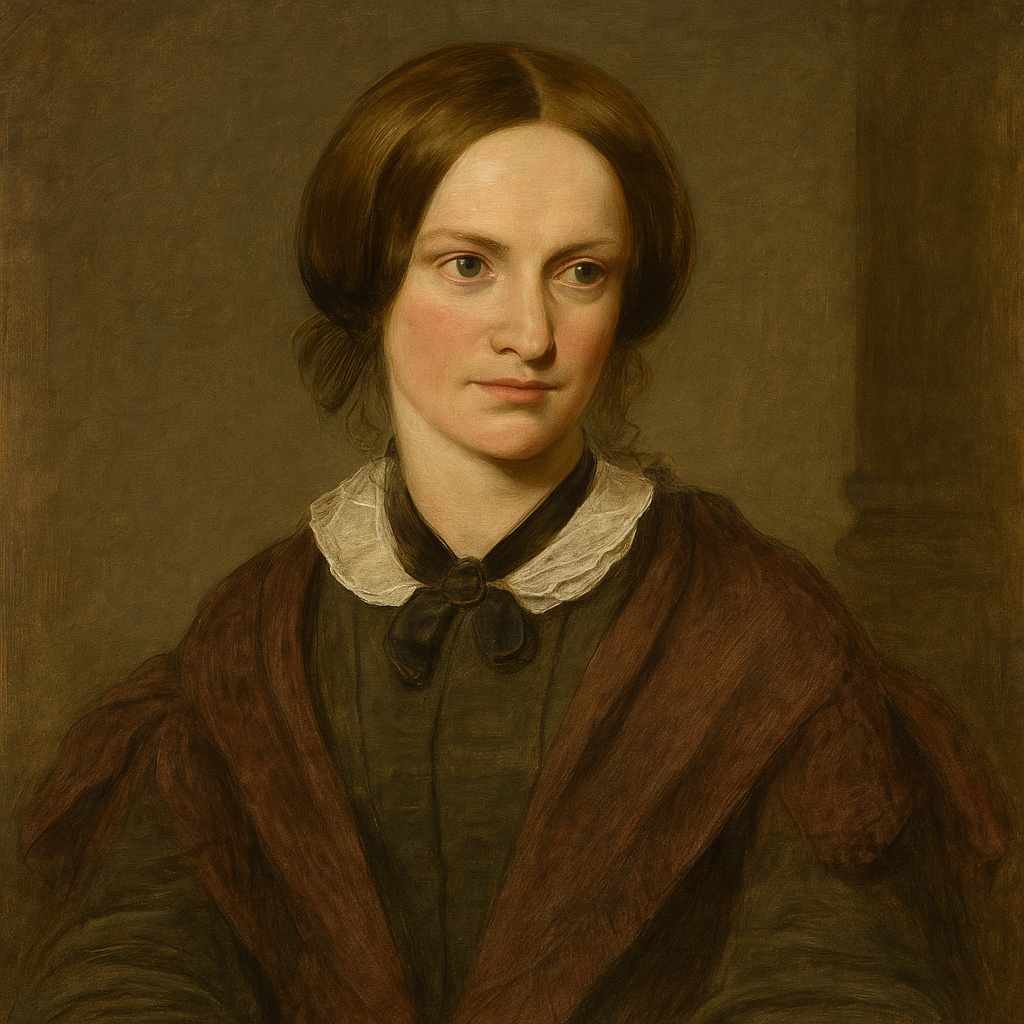The Letter
Charlotte Brontë
1816 to 1855

What is she writing? Watch her now,
How fast her fingers move!
How eagerly her youthful brow
Is bent in thought above!
Her long curls, drooping, shade the light,
She puts them quick aside,
Nor knows that band of crystals bright,
Her hasty touch untied.
It slips down her silken dress,
Falls glittering at her feet;
Unmarked it falls, for she no less
Pursues her labour sweet.
The very loveliest hour that shines,
Is in that deep blue sky;
The golden sun of June declines,
It has not caught her eye.
The cheerful lawn, and unclosed gate,
The white road, far away,
In vain for her light footsteps wait,
She comes not forth to-day.
There is an open door of glass
Close by that lady’s chair,
From thence, to slopes of messy grass,
Descends a marble stair.
Tall plants of bright and spicy bloom
Around the threshold grow;
Their leaves and blossoms shade the room
From that sun’s deepening glow.
Why does she not a moment glance
Between the clustering flowers,
And mark in heaven the radiant dance
Of evening’s rosy hours?
O look again! Still fixed her eye,
Unsmiling, earnest, still,
And fast her pen and fingers fly,
Urged by her eager will.
Her soul is in th’absorbing task;
To whom, then, doth she write?
Nay, watch her still more closely, ask
Her own eyes’ serious light;
Where do they turn, as now her pen
Hangs o’er th’unfinished line?
Whence fell the tearful gleam that then
Did in their dark spheres shine?
The summer-parlour looks so dark,
When from that sky you turn,
And from th’expanse of that green park,
You scarce may aught discern.
Yet, o’er the piles of porcelain rare,
O’er flower-stand, couch, and vase,
Sloped, as if leaning on the air,
One picture meets the gaze.
‘Tis there she turns; you may not see
Distinct, what form defines
The clouded mass of mystery
Yon broad gold frame confines.
But look again; inured to shade
Your eyes now faintly trace
A stalwart form, a massive head,
A firm, determined face.
Black Spanish locks, a sunburnt cheek
A brow high, broad, and white,
Where every furrow seems to speak
Of mind and moral might.
Is that her god? I cannot tell;
Her eye a moment met
Th’impending picture, then it fell
Darkened and dimmed and wet.
A moment more, her task is done,
And sealed the letter lies;
And now, towards the setting sun
She turns her tearful eyes.
Those tears flow over, wonder not,
For by the inscription see
In what a strange and distant spot
Her heart of hearts must be!
Three seas and many a league of land
That letter must pass o’er,
Ere read by him to whose loved hand
‘Tis sent from England’s shore.
Remote colonial wilds detain
Her husband, loved though stern;
She, ‘mid that smiling English scene,
Weeps for his wished return.
Charlotte Brontë's The Letter
Introduction
Charlotte Brontë's poem "The Letter" is a masterful exploration of longing, devotion, and the power of the written word to bridge vast distances. This 19th-century work, penned by one of literature's most celebrated authors, offers a poignant glimpse into the emotional landscape of a woman separated from her beloved. Through vivid imagery and meticulous detail, Brontë crafts a narrative that resonates with themes of isolation, commitment, and the complexities of married life in the Victorian era. This analysis will delve into the poem's structure, imagery, and thematic elements to uncover the layers of meaning woven into its verses.
Structure and Form
Brontë's poem unfolds through twenty-three meticulously crafted quatrains, each adhering to an ABAB rhyme pattern. This structured approach not only echoes the rigid decorum of Victorian society but also mimics the methodical, almost ritualistic nature of composing a letter. The poem's rhythm, characterized by alternating lines of iambic tetrameter and trimeter, produces a lyrical cadence that gently ushers the reader into the private world of the letter-writer. This careful attention to form serves a dual purpose: it provides a pleasing musicality to the verse while simultaneously immersing the audience in the intimate tableau Brontë paints with her words.
Brontë's choice of form is particularly significant when considering the subject matter. The act of writing a letter is inherently structured, much like the poem itself. This parallel between content and form reinforces the central theme of communication across distances, both physical and emotional.
Imagery and Symbolism
The poem is rich with vivid imagery that serves to paint a detailed picture of the scene while simultaneously conveying deeper symbolic meanings. The opening stanzas focus on the physical act of writing, with descriptions of the lady's "fast her fingers move" and her "youthful brow / Is bent in thought above." These images not only set the scene but also emphasize the intensity and focus of the letter-writer.
Symbolism abounds in the portrayal of the surrounding environment. The "deep blue sky" and "golden sun of June" represent the beauty and vitality of the world outside, contrasting sharply with the lady's self-imposed isolation. The "unclosed gate" and "white road, far away" symbolize potential freedom and escape, yet the lady "comes not forth to-day," underscoring her commitment to her absent husband and her task.
The "open door of glass" and the "marble stair" leading to "slopes of messy grass" create a liminal space between the interior world of duty and the exterior world of nature and possibility. This threshold, adorned with "plants of bright and spicy bloom," serves as a metaphor for the temptations and distractions that the lady resolutely ignores in favor of her "absorbing task."
Characterization and Psychology
Brontë masterfully develops the character of the letter-writer through subtle details and actions. The lady's dedication is evident in her unwavering focus, as she "puts them quick aside" when her curls fall in her face. The fallen "band of crystals bright" goes unnoticed, symbolizing her disregard for personal adornment and worldly concerns in the face of her emotional priorities.
The poem offers a nuanced psychological portrait of a woman caught between duty and desire. Her steadfast commitment to writing is juxtaposed with moments of emotional vulnerability, as when "a tearful gleam" shines in her eyes. This interplay between external composure and internal turmoil is a hallmark of Victorian literature, reflecting the societal expectations placed upon women of the era.
The Absent Husband
The subject of the lady's letter—her "husband, loved though stern"—is a spectral presence throughout the poem. His physical absence is counterbalanced by his emotional significance, embodied in the "clouded mass of mystery" contained within the picture frame. The description of his "stalwart form" and "firm, determined face" contrasts with the lady's more delicate presence, suggesting traditional gender roles while also hinting at the strength of character that binds these two individuals across vast distances.
The phrase "loved though stern" encapsulates the complex nature of their relationship, implying both affection and a certain emotional reserve. This nuanced portrayal adds depth to the poem's exploration of marital bonds and the sacrifices demanded by long-distance relationships.
Themes of Isolation and Connection
At its core, "The Letter" is an examination of the tension between isolation and connection. The lady's physical solitude is palpable, emphasized by the vibrant world she ignores beyond her window. Yet, through the act of writing, she forges a powerful connection across "three seas and many a league of land."
This theme resonates particularly strongly when considered in the context of Brontë's own life and the broader colonial context of Victorian England. The reference to "remote colonial wilds" places the poem within the framework of empire, suggesting the personal costs of imperial ambition and the ways in which individuals sought to maintain bonds across global distances.
The Power of the Written Word
Ultimately, "The Letter" is a testament to the power of writing itself. The lady's intense focus on her task underscores the importance of this communication. In an era before instant messaging and video calls, letters were lifelines, carrying not just information but emotion and presence across vast distances.
Brontë, herself a master of the written word, imbues the act of writing with almost mystical significance. The letter becomes a physical manifestation of love and commitment, a bridge spanning not just physical distance but the emotional gap inherent in long separations.
Conclusion
Charlotte Brontë's "The Letter" is a masterpiece of Victorian poetry, combining technical skill with deep emotional resonance. Through its careful structure, vivid imagery, and nuanced characterization, the poem offers a window into the complexities of long-distance relationships in the 19th century while also touching on universal themes of love, duty, and the power of communication.
The work stands as a testament to Brontë's skill as a poet, demonstrating her ability to convey complex emotional landscapes within the constraints of poetic form. Moreover, it serves as a poignant reminder of the enduring human need for connection, and the lengths to which individuals will go to maintain bonds of love and commitment across any distance.
In its exploration of a private moment imbued with deep significance, "The Letter" invites readers to consider their own experiences of separation and reunion, of writing and being written to. It is a poem that continues to resonate, speaking to the timeless human desire to reach out across the void and touch the hearts of those we hold dear.
This text was generated by AI and is for reference only. Learn more
Want to join the discussion? Reopen or create a unique username to comment. No personal details required!



Comments
No comments yet. Be the first to comment!